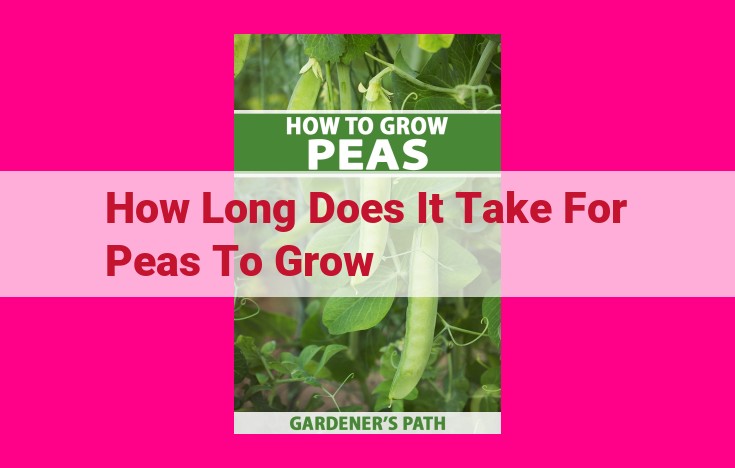Peas: A Comprehensive Guide To Growth Stages, Time To Maturity, And Yield Optimization

Peas typically take 60-80 days to mature from seed to harvest. The growth stages include germination (7-10 days), seedling (10-14 days), vegetative growth (21-28 days), flowering (7-14 days), pod development (21-28 days), and seed maturity (14-21 days). Environmental factors such as soil temperature, moisture, and sunlight, as well as agricultural practices like variety selection, plant spacing, and trellising, influence the growth and yield of peas.
The Enchanting Journey of a Pea Plant: From Seed to Harvest
Embark on a captivating exploration of the life cycle of the beloved pea plant, from its humble beginnings as a tiny seed to its bountiful harvest. Each stage of its growth is a testament to the resilience and beauty of nature.
Germination: The Miracle of Rebirth
Nestled within the earth’s warm embrace, the pea seed awaits the perfect moment to awaken. With adequate moisture and the right temperature, it absorbs water and begins to germinate. A tiny root emerges, anchoring the plant as a small shoot reaches towards the light.
Seedling Stage: The Foundation of Life
As the seedling grows, it develops its first true leaves, absorbing sunlight and nutrients. Roots expand, forming a strong network that supports the plant’s upward climb.
Vegetative Growth: A Surge of Vitality
In the vegetative growth phase, the pea plant enters a period of rapid expansion. Its stems lengthen, and leaves become lush and abundant. This surge in growth prepares the plant for the next crucial stage: flowering.
Flowering: A Dance of Beauty
During flowering, delicate pea blossoms emerge, pollinating insects flutter from flower to flower, spreading the plant’s genetic material. Successful pollination initiates the formation of pea pods, each a tiny vessel that will nurture the next generation.
Pod Development: A Promise of Harvest
Pea pods grow steadily, their soft green shells protecting the developing peas within. Factors such as sunlight, water, and soil fertility influence the size and yield of the pods.
Seed Maturity: The Culmination of Growth
As the summer sun ripens the pods, the peas mature, their plump seeds hardening within. When the pods turn brown and dry, it’s time for harvest, the culmination of the pea plant’s remarkable journey.
Environmental Factors Influencing Pea Plant Growth
The growth and development of pea plants are significantly influenced by a range of environmental factors, including soil temperature, soil moisture, and sunlight.
Soil Temperature
Pea plants prefer well-drained, fertile soil with a pH between 6.0 and 7.0. When it comes to soil temperature, different growth stages have varying requirements. For optimal germination, soil temperatures should range between 50-60°F (10-16°C). During vegetative growth, slightly warmer soil temperatures between 60-70°F (16-21°C) promote rapid growth. However, extremely high soil temperatures can inhibit root development and overall plant health.
Soil Moisture
Pea plants have moderate water requirements throughout their growth cycle. Consistent moisture levels are essential, especially during germination and vegetative growth stages. Avoid overwatering, as waterlogged soil can lead to root rot and other diseases. Drought stress can stunt plant growth, reduce yields, and make plants more susceptible to pests and diseases.
Sunlight
Pea plants thrive in full sun, requiring at least 6-8 hours of direct sunlight per day. Intense sunlight can lead to leaf scorch, reduced plant growth, and lower yields. In areas with high light intensity, it may be necessary to provide shade for pea plants during the hottest part of the day. Alternatively, pea plants can be grown in locations with partial shade, but this may result in slower growth and reduced yields compared to plants grown in full sun.
Agricultural Practices for Enhanced Pea Plant Production
Nurturing pea plants to reach their fullest potential requires meticulous agricultural practices that cater to their unique growth habits. From selecting the right variety to providing adequate support, these practices play a crucial role in maximizing yield, improving plant health, and facilitating efficient harvesting.
Variety Selection: Tailoring Growth to Growing Conditions
Pea plant varieties exhibit a wide range of growth characteristics, catering to diverse growing conditions and cultivation goals. Understanding these variations is essential for selecting the most suitable variety for your specific circumstances.
- Early-maturing varieties: Ideal for short growing seasons or regions with late spring frosts.
- Mid-season varieties: Strike a balance between earliness and yield potential, suitable for most climates.
- Late-season varieties: Produce the highest yields but require a long growing season and are best suited for warmer areas.
Optimal Plant Spacing: Maximizing Growth and Yield
Proper spacing between pea plants ensures adequate aeration, sunlight penetration, and root development, ultimately contributing to optimal yield.
- Recommended spacing: Varies depending on variety and growing conditions, typically ranging from 2 to 4 inches apart.
- Dense planting: While increasing plant population can boost yields, it may also lead to competition for resources and disease susceptibility.
- Wide spacing: Provides ample space for individual plants to thrive, resulting in improved plant health and easier harvesting.
Trellising Systems: Encouraging Growth and Facilitating Harvesting
Providing support for pea plants with trellises or other support systems offers several advantages:
- Increased Yield: Trellising allows plants to grow vertically, maximizing sunlight exposure and improving pod set.
- Improved Air Circulation: By elevating plants off the ground, trellises promote better air circulation, reducing disease incidence.
- Easier Harvesting: Trellising facilitates easier access to pods, making harvesting more efficient and reducing the risk of plant damage.
By implementing these agricultural practices, pea plant growers can optimize growth conditions, maximize yield, and ensure the health and productivity of their crops. Understanding the unique needs of different pea plant varieties and adjusting spacing and support systems accordingly is essential for successful pea plant cultivation.